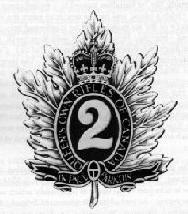
The Queens Own Rifles of Canada are a reserve unit, but the only one in Canada that's primarily an airborne unit.
The organization of the unit is:
Battalion Headquarters
- 60th Company
- Buffs Company
- Victoria Company (Logistics company)
- Regimental Band and Bugles
- 2881 Queen’s Own Rifles Cadet Corps
The website run by the regiment has a treasure trove of photos from all sorts of activities.
The early history of the regiment actually predates the formation of Canada.
The Queen's Own Rifles of Canada was formed on April 26, 1860. Originally the Regiment's name was the Second Battalion, Volunteer Militia Rifles of Canada. The cap badge still bears the number two as recognition of the unit's seniority. In 1863 the name changed to 2nd Battalion "Queen's Own Rifles of Toronto." It was under this name that the regiment fought at the Battle of Ridgeway, during the Fenian Raids of 1866. Thereafter, the unit was called the 2nd Battalion "Queen's Own Rifles of Canada" in 1882.There's plenty more after this, too.
When Louis Riel launched the North-West Rebellion in 1885, the "Queen's Own" fought the Cree Chief Poundmaker at the Battle of Cut Knife Hill. The Regiment's first overseas action came when the Queen's Own provided thirty-three soldiers for duty in the South African War 1899-1900. These men became part of "C" Company (representing Toronto), of the 2nd (Special Service) Battalion, Royal Canadian Regiment.
When World War I broke out in August of 1914, Canada responded by sending the Canadian Expeditionary Force. The Regiment provided the bulk of the men to the Third Battalion CEF, however, Ottawa refused to allow the battalion to wear the Queen's Own cap badge. Initially, many thought the Queen's Own would be allowed to retain its Regimental identity. Instead, small groups from the 10th Grenadiers and the Governor General's Bodyguard were posted into the already over-strength battalion, making it the Toronto regiment, a composite unit. 3Bn CEF fought in Northern France and Belgium, from Amiens to Langemark. Twenty one battle honours, were won during the war. By the war's end 7,562 Queen's Own had served overseas, of these 1,254 were killed in action, died of wounds or of other causes.
Upon returning home, the officers of the Third Battalion found they could not resolve their conflicts with the officers of the Queen's Own who had not fought in Europe. The solution came with the formation of the Toronto Regiment that was officially authorized on May 1, 1920. This was also the date of the unit's last name change. It became The Queen's Own Rifles of Canada, leaving out the "Second" designation.
The Queen's Own was mobilized for the Second World War on May 24th, 1940. The Regiment's first assignment was the defence of Newfoundland and New Brunswick. Eventally, the Regiment was posted to England, in July 1941, as a part of the 8th Canadian Infantry Brigade of the 3rd Canadian Division. The Queen's Own first action, was in the leading wave of the D-Day invasion. The Regiment landed on Bernieres-sur-Mer at 08:12hrs, on the 6th of June 1944. The fighting took them through Normandy and into Northern France. The Regiment fought their way north into Belgium, freeing the crutial channel ports.
The Wikipedia page has a lot of details, as well.
By: Brant




No comments:
Post a Comment